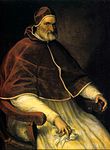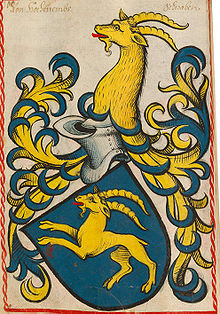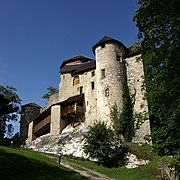Lords of Ems
The lords of Ems were an ancient noble family and knights in Vorarlberg .
When the brother of a woman from Ems was elected Pope Pius IV in 1559 , his nephews received the status of imperial count as von Hohenems in 1560 . One of the papal nephews, Cardinal Markus Sittikus von Hohenems (1538–1595), became Bishop of Constance, but resided in Rome. His illegitimate son Roberto founded an Italian line that became Dukes of Gallese , Margraves of Soriano and Princes of Altems under the name Altemps and only went out in 1964.
The Vorarlberg Line acquired the County of Vaduz in 1613 and split up in 1646 into the Counts of Hohenems- Lustenau and Hohenems- Vaduz, who were directly part of the empire . The Vaduz line came through abusive witch trials under imperial execution and in debt and had to sell their county to the Liechtensteiners in 1712 . The male line of the Lustenau line died out in 1759, its territory fell to Austria and in 1790 to the House of Waldburg-Zeil-Hohenems .
Family history
middle Ages
Along with the Counts of Montfort, the Lords of Ems were the most important noble family in Vorarlberg . The family can be traced back to the year 1170 . In 1160 a Hainricus de Amedes (Amides, Ems) is mentioned as a witness in a document. The brothers "Rudolfus et Goswinus de Amides" appear after 1170 as ministerials of the Hohenstaufen Friedrich von Schwaben . First Guelph , then Hohenstaufen Ministeriale, they controlled the Rhine Valley from Vaduz to Lake Constance .
The blinded, emasculated Wilhelm III. von Sicily , the last Norman king from the Hauteville family , was imprisoned by the Lords of Ems in the Alt-Ems Castle from 1195 until his death at the age of 13 . Between 1206 and 1207, the Archbishop of Cologne Bruno IV von Sayn was also held captive at Alt-Ems Castle.
The activity of the members of the Ems family in the Austrian service led to a rapid rise of the sex. In addition, the Emsern succeeded in bringing sovereign rights into their hands through loans to various emperors and the imperial pledges granted in return. In 1333 Ems Ludwig the Bavarian gave Ems the rights and freedoms of the imperial city of Lindau , which the Lords of Ems could never implement. In 1453 the title of Ems was supplemented by the addition of Hohenems .
Imperial counties from the 16th to the 18th centuries
In the opposite direction to the general decline of the knightly nobility in the 16th century, the lords of Ems succeeded in expanding their rule and ascending to the imperial nobility .

Marx Parakeet I. von Ems (1466–1533) became colonel and general of the Swabian Confederation. During campaigns in Italy around 1530 he succeeded in marrying one of his sons, Wolf-Dietrich (1507-1538), with Clara Medigino from a Milanese family, whose brother Gian Giacomo "Il Mendeghino" († 1555) a condottiere and their others Brother, Giovanni Angelo, who was a cardinal. The latter took the name and coat of arms of the (unrelated) Florentine Medici family and was elected Pope Pius IV in 1559 . He immediately endowed his numerous Italian and German nephews with benefits to ensure his power. As early as April 27, 1560, the sons of Wolf-Dietrich (Jakob Hannibal, later Cardinal Marx Sittich III and Gabriel) and their cousin Marx Sittich II were elevated to the rank of imperial count by the emperor .
Markus Sittikus von Hohenems was created cardinal by his papal uncle in 1561 and promoted to governor of the Ancona region . From 1561 to 1589 he was Bishop of Constance and then at the Curia in Rome. Markus Sittikus' brother Jakob Hannibal von Hohenems became general of the troops of Charles V and Philip II. Cousins were Cardinal Karl Borromeo from Milan and Cardinal Federico Borromeo , nephews were Wolf Dietrich von Raitenau , who later became Prince Archbishop of Salzburg (1587-1612), and Markus Sittikus IV. von Hohenems (youngest son Jakob Hannibal), who should also rise to the rank of Prince Archbishop of Salzburg (1612 to 1619).

Count Kaspar von Hohenems acquired the county of Vaduz and the rule of Schellenberg from the counts of Sulz in 1613 . In 1646 the imperial dominions Hohenems-Lustenau and Hohenems-Vaduz came into being . The Hohenems rule included the castles Alt-Ems (since approx. 1240) and Neu-Ems (since 1343), the Oberdorfer Thurn (since 1465) in Dornbirn and Vaduz Castle (since 1613). The places Dornbirn , Widnau-Haslach , since 1578 the county Gallara near Milan, the county Vaduz and rule Schellenberg since 1613 (from which 1699 and 1712 Liechtenstein arose), the rule Lustenau in Vorarlberg, Widnau in Switzerland as well as Polička , Bonna , Trepien , Laubendorf and Bistrau in Bohemia.
Because of years of excessive witch hunts and misappropriation of property of those executed was in 1681 against the reigning count Ferdinand Karl von Hohenems-Vaduz (1650-1686) the Reichsexekution initiated, the count was in 1683 arrested by imperial order, lost by order of the Reich privy councilor in 1684, the ruling authority and at the same time was obliged to return the confiscated property to the bereaved. Since the heavily indebted Count House was unable to do this, Ferdinand Karl's successor, his brother Jakob Hannibal (1653–1730) , was again under compulsory administration and in 1699 the Schellenberg reign was sold, and in 1712 the Vaduz county to Prince Johann Adam von Liechtenstein .
1759 died with Franz Wilhelm III. the Counts of Hohenems-Lustenau in the male line and the sovereignty came to Austria .
Heirs: Waldburg-Zeil-Hohenems

Maria Rebecca Countess of Harrach-Hohenems received the rule of Lustenau back in 1790 after the state treaty with Austria. Her daughter Maria Walburga Harrach married Clemens Alois von Waldburg-Zeil-Hohenems (1753-1817). The sovereign state of Lustenau under the ruling Counts of Waldburg-Zeil-Lustenau-Hohenems fell to the Kingdom of Bavaria after the end of the Holy Roman Empire in 1806 . In 1811 and 1813, Bavaria had to relinquish sovereignty to the House of Waldburg-Zeil-Hohenems. In 1814 Austria set up a provisional administration in Lustenau. Bavaria, like Waldburg-Zeil, protested. In 1817 Lustenau was again transferred to Waldburg-Zeil. In view of financial burdens and the resulting sovereign waiver by Count Maximilian (1799–1868), in 1830 Lustenau's statehood was finally transferred to Austria.
Italian line: Altemps

The Prince-Bishop of Constance and later Cardinal Curia Markus Sittikus von Hohenems , acquired the Palazzo Riario (later called Palazzo Altemps ) in Rome in 1568 and housed his collection of antiquities there, which later came to the Vatican Museums. One of the natural sons of the cardinal, Roberto Altemps (ca. 1566-1586), of the name of Hohenems to Altemps Latinized ( altus = high ), was Sixtus V in his early years as commander of the papal troops in Avignon and Duke of Gallese appointed . However, when he married Cornelia Orsini , whose family was one of the Pope's sharpest enemies, he had him beheaded at the age of only 20 for alleged adultery. His descendants formed the Italian dynasty Altemps (which should not be confused with the Italian-born Austrian Counts von Attems ). It was not until 1964 that the Italian line died out with Don Alessandro Duca Altemps in the male line. The titles Duca di Altemps , Marchese (Margrave) di Soriano , Conte (Count) di Meduraca and Signore (Herr) di Tassignano passed to his grandson, Principe Don Alessandro Boncompagni-Ludovisi- Rondinelli-Vitelli-Altemps (* 1972).
coat of arms
The coat of arms of the Lords of Ems shows an ibex on a blue shield.
Cardinal Markus Sittikus added that of the Medici to his family coat of arms, as well as the red cross of the Constance diocese coat of arms.
The coat of arms lives on in today's municipal coat of arms of the city of Hohenems . The municipal coat of arms was awarded by the Vorarlberg state government on September 29, 1928.
people
- Rudolf von Ems (* around 1200; † around 1254), poet
- Knight Ulrich I von Ems , built Glopper Castle in 1343
- Knight Ulrich II von Ems , the rich : On May 21, 1388 he bought the church set and the widum of Dornbirn from Weingartner abbot Ludwig for 300 pounds from Haller
- Osanna von Ems († after 1418), granddaughter of the knight Ulrich I von Ems and a daughter from the Schellenberg family , wife of the knight Sigmund von Starkenberg († 1401). After his death, she was the guardian of her sons Ulrich and Wilhelm von Starkenberg
- Merk (Marx) Parakeet I. von Ems (* 1466; † 1533): As a general of the Swabian Confederation, he defeated the rebellious farmers on Lake Constance in the Peasants' War in 1525. He also fought alongside servant leader Frundsberg and Truchsess Georg von Waldburg ("Bauernjörg") in the Swabian Wars and in northern Italy. During his campaigns in Italy he managed to marry one of his sons, Wolf-Dietrich, to a sister of the future Pope Pius IV . This marked the beginning of a steep rise in the Emser's power and family politics.
- Georg Sigmund von Ems (* 1494; † 1547): The Konstanz canon , a son of Merk Parakeet I, was chosen by King Ferdinand I as a candidate for the office of bishop in Konstanz in 1532.
- Wolf-Dietrich von Ems (* 1507; † 1538) ∞ Clara de Medici, sister of the later Pope Pius IV.
- Jakob Hannibal von Hohenems (* 1530; † 1587): Imperial Count of Hohenems, leader of the Vatican troops, later papal legate
- Markus Sittikus (III.) Von Hohenems (* 1533; † 1595): Bishop of Constance, cardinal, builder of the Palazzo Altemps in Rome and the Villa Mondragone
- Kaspar von Hohenems (* 1573; † 1640): Count of Hohenems, commissioner of the Emser Chronicle
- Markus Sittikus (IV.) Von Hohenems (* 1574; † 1619): Prince-Archbishop of Salzburg, builder of Hellbrunn Palace in Salzburg
- Ferdinand Karl Franz, Count von Hohenems (* 1650; † 1686): responsible for witch trials in Liechtenstein
- Franz Rudolph von Hohenems (* 1686; † 1756), Imperial Field Marshal and General of the Cavalry

Marx Parakeet I. von Ems (1466–1533), colonel, general of the Swabian Confederation
Cardinal Markus Sittikus (III.) Von Hohenems (* 1533; † 1595), Bishop of Constance
Kaspar Imperial Count of Hohenems (1573–1640)
Markus Sittikus (IV.) Von Hohenems (* 1574; † 1619), Prince Archbishop of Salzburg
Castles and Palaces
Alt-Ems
→ Main article: Alt-Ems
This castle complex near Hohenems in Vorarlberg was located 740 meters above sea level, about 300 meters above the Rhine Valley on the vertically rising rocky ridge.
The originally Guelph and from 1179/1191 Staufer castle was owned by the Ems ministerial and since the end of the 12th century the Alt-Ems castle has been one of the most powerful and largest castle complexes in all of southern Germany.
The Staufer fortress served, among other things, as a repository for prominent prisoners such as Wilhelm III from 1195 . (Sicily) or in 1206 Archbishop Bruno of Cologne .
In 1406 the castle complex was destroyed in the Appenzell War.
Neu-Ems Castle (Glopper Castle)
→ Main article: Neu-Ems Castle
In 1343, knight Ulrich I von Ems built a new castle on the ridge of the Rhine Valley in Emsreute, with the permission of Emperor Ludwig of Bavaria , near his fortress Alt-Ems, in order to create a permanent refuge for his large family in troubled times. In 1407 during the Appenzell War, the castle of the former Counts of Hohenems was destroyed for the first time and immediately rebuilt.
In 1603 a chapel was set up on the ground floor, of which no remains have survived except for two pointed arched windows in the north wall. The former winged altar of this chapel (Antwerp master, around 1515–1520) has been in the Tyrolean State Museum since 1835 . Since 1843, this exceptionally uniform architectural ensemble of small-scale stronghold is with bergfriedartigem bulwark attached Palas and of deeper Vorburg privately owned family Waldburg-Zeil .
Hohenems Palace
→ Main article: Hohenems Palace
The Hohenems Palace was built between 1562 and 1567 in the valley below Alt-Ems Castle and was the residential palace of the Counts of Hohenems. Today the palace is privately owned by the descendants of the Counts Waldburg-Zeil-Hohenems.
literature
- Joseph Bergmann : The nobles from Embs to Honenembs in Vorarlberg . in: Memoranda of the philosophical-historical class of the Imperial Academy of Sciences, Volume X, Vienna 1860, pp. 93–194 ( digitized version ).
- Joseph Bergmann: The imperial counts from and to Hohenems in Vorarlberg. In: Memoranda of the philosophical-historical class of the Imperial Academy of Sciences, XI. Volume, Vienna 1861 ( digitized reprint ).
- Karl Heinz Burmeister : Hohenems, from. In: Historical Lexicon of Switzerland . 2008.
- Gerhard Köbler : Historical lexicon of the German countries. The German territories from the Middle Ages to the present. 7th, completely revised edition. CH Beck, Munich 2007, ISBN 978-3-406-54986-1 .
- Ludwig Welti: Hohenems, Count of. In: New German Biography (NDB). Volume 9, Duncker & Humblot, Berlin 1972, ISBN 3-428-00190-7 , p. 479 f. ( Digitized version ).
- Constantin von Wurzbach : Hohenembs, the counts, genealogy . In: Biographisches Lexikon des Kaiserthums Oesterreich . 9th part. Kaiserlich-Königliche Hof- und Staatsdruckerei, Vienna 1863, p. 189 ( digitized version ).
Web links
- The Counts of Hohenems , article by Karl Heinz Burmeister at Vorarlberg Chronik
Individual evidence
- ↑ Count of Hohenems
- ^ The Counts of Hohenems (in the Vorarlberg Chronicle)
- ↑ Bundesdenkmalamt (BDA) A-1010 Vienna, Hofburg (accessed on February 10, 2010)
- ^ The Counts of Hohenems, State of Vorarlberg (accessed February 10, 2010)
- ↑ Ludwig Welti: History of the Reichsgrafschaft Hohenems and the Reichshof Lustenau . Ed .: Historical Commission for Vorarlberg and Liechtenstein (= research on the history of Vorarlberg and Liechtenstein . Volume 4). University publishing house Wagner, Innsbruck 1930, p. 57 .
- ↑ Ludwig Welti: History of the Reichsgrafschaft Hohenems and the Reichshof Lustenau . Ed .: Historical Commission for Vorarlberg and Liechtenstein (= research on the history of Vorarlberg and Liechtenstein . Volume 4). University publishing house Wagner, Innsbruck 1930, p. 90 .
- ↑ Entry on Rudolf von Ems in the Austria Forum (in the AEIOU Austria Lexicon )
- ↑ Notes on Osanna von Ems and Starkenberg in Ute Monika Schwob: "Mistresses" in Tyrolean sources. On the legal and social position of noble women in the Middle Ages. In: Egon Kühebacher (Hrsg.): Literature and fine arts in the Tyrolean Middle Ages. The Iwein frescos by Rodenegg and other evidence of the interaction between literature and the fine arts (= Innsbruck contributions to cultural studies. Germanistic series 15), Innsbruck 1982, p. 171f.
- ↑ http://geneall.net/de/name/1785660/ferdinand-karl-franz-graf-von-hohenems/
- ^ Manfred Tschaikner : Hohenems reign of terror in Vaduz and Schellenberg? - Count Ferdinand Karl von Hohenems and the witch trials (1675-1685). In: Montfort, Vol. 64, Vol. 2 (2012), pp. 87-99










